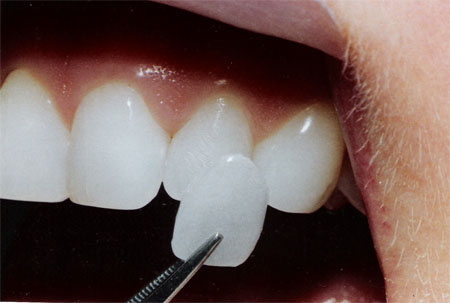E-DENTAL
Family & Cosmetic Dentistry


How the Dental Veneers Process Works: What to Expect at Every Stage?
Dental veneers are a popular cosmetic dental treatment for people seeking a smile makeover. Whether you’re dealing with chipped, stained, or misaligned teeth, dental veneers provide a fast and effective solution to enhance your smile.
If you’ve been considering veneers, you might be wondering: how does the dental veneers process work, and what can you expect at each stage?
In this guide, we’ll take you through the veneers dental procedure step by step, ensuring you know exactly what to expect and how to prepare. By understanding the stages of the process, you’ll feel more confident and informed when deciding whether dental veneers are right for you.
What Are Dental Veneers?
Before diving into the process, it’s important to understand what dental veneers are. Dental veneers are thin, custom-made shells, typically made from porcelain or composite resin, designed to cover the front surface of teeth to improve their appearance. They are bonded to the teeth to address issues like discoloration, chips, cracks, and even gaps.
Step 1: Initial Consultation
The first stage in the dental veneers process involves an initial consultation with your dentist. During this visit, your dentist will assess your oral health and discuss your aesthetic goals. They will also evaluate your teeth to determine whether veneers are a suitable option for you.
You should expect:
- X-rays and Impressions: Your dentist may take X-rays of your teeth and make impressions to create a precise plan for your veneers.
- Discussion of Options: Your dentist will discuss the various types of dental veneers available, including porcelain and composite veneers. Porcelain veneers are known for their durability and natural appearance, making them a top choice for many patients.
- Expectations and Costs: You will discuss the costs involved and the potential outcomes. Veneers are a cosmetic procedure that is not typically covered by insurance; therefore, your dentist will outline payment options.
Step 2: Preparing Your Teeth
Once you and your dentist have decided to proceed with the procedure, the next step is to prepare your teeth. This step typically requires two visits, as the process involves shaping the teeth to make room for the veneers.
You will get:
- Tooth Reduction: Your dentist will remove a small amount of enamel from the front of your teeth to achieve a more aesthetically pleasing appearance. This step ensures that the veneers will fit properly and create a natural look. The amount of enamel removed is minimal, and the procedure is typically performed under local anesthesia to ensure patient comfort.
- Impressions: After preparing your teeth, your dentist will take impressions of them, which will be sent to a dental laboratory. The lab will craft your custom veneers based on these impressions. This process typically takes a few weeks, so you may be given temporary veneers to wear in the meantime.
- Temporary Veneers: While your permanent veneers are being created, temporary veneers may be placed to protect your teeth and provide a preview of your new smile. These temporary veneers are not as durable or aesthetically pleasing as your final ones, but they serve as a placeholder.
Step 3: The Veneer Fitting Appointment
After your veneers have been custom-made to fit your teeth perfectly, it’s time for the fitting appointment. This is the most exciting step, as it’s when you’ll get a firsthand look at your new smile.
Your dentist will place the veneers on your teeth temporarily to ensure they fit properly and match the color of your natural teeth. If necessary, the dentist will make minor adjustments to achieve the perfect fit.
Once you’re satisfied with the fit and look, your dentist will permanently bond the veneers to your teeth. This involves cleaning and preparing your teeth, applying a bonding agent, and then securing the veneers with a special resin. The veneers are then cured with a special light to ensure a strong bond.
After the veneers are bonded, your dentist will make any final adjustments to ensure they feel comfortable and look natural. This may involve some reshaping or polishing to achieve the perfect finish for your veneers.
Step 4: Aftercare and Maintenance
Now that your veneers are in place, it’s important to take care of them to ensure their longevity. Proper maintenance is key to enjoying the benefits of your new smile for years to come.
Continue to brush and floss your teeth regularly, ensuring you clean around your veneers to maintain optimal oral hygiene. Veneers themselves are resistant to staining, but the surrounding gums and teeth still require proper care and maintenance.
While dental veneers are durable, they are not indestructible. You should avoid biting on hard objects, such as ice, pens, or fingernails, as they can cause chips or cracks.
Regular dental visits will help ensure your veneers stay in top shape and that your oral health remains intact.
Are Dental Veneers Permanent?
One of the most common questions patients have about the dental veneers procedure is whether dental veneers are permanent. While veneers are long-lasting, they are not forever. Over time, they may need to be replaced due to wear and tear or if they become damaged. However, with proper care, veneers can last anywhere from 10 to 20 years.
Are Dental Veneers Worth It?
Many patients wonder whether the investment in dental veneers is worthwhile. Veneers can drastically improve the appearance of your smile, boosting your confidence and self-esteem. If you’re bothered by imperfections such as discoloration or minor tooth damage, veneers are an excellent way to achieve a beautiful, natural-looking smile. While they can be expensive, they often offer a better and longer-lasting solution than other cosmetic procedures.
Types of Dental Veneers
There are two primary types of dental veneers: porcelain veneers and composite resin veneers. Each has its benefits and is suited for different needs.
Porcelain Veneers
These are the most popular type and are known for their natural look and durability. Porcelain veneers resist staining better than composite veneers, making them a great choice for individuals seeking a long-lasting, low-maintenance option.
At E Dental, we work with this type of veneer.
Composite Resin Veneers
These are less expensive and can be placed in a single visit, but they may not last as long as porcelain veneers. They are also more susceptible to staining, so that they may require more frequent maintenance.
Conclusion
The dental veneers process is straightforward, but it’s important to work with a skilled cosmetic dentist who can guide you through each stage.
From your initial consultation to your final fitting, each step is designed to create a smile you can be proud of. Whether you’re looking to enhance the color, shape, or size of your teeth, veneers can provide an effective and lasting solution. With proper care, your new smile could last for many years, helping you feel more confident every day.
Remember, if you’re unsure about whether dental veneers are the right option for you, it’s always a good idea to consult with a dentist who specializes in cosmetic dentistry. They’ll help you decide if veneers are the best solution to meet your aesthetic goals.
If you’re looking for veneers in Seminole or Apollo Beach, Florida, come to E Dental. Our family & cosmetic dentistry is here to help you smile again.
Complete the form below and one of our staff will contact you to confirm




